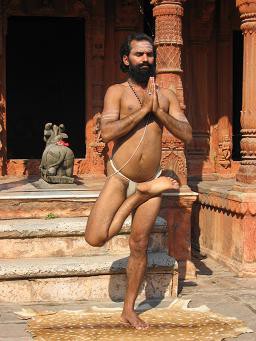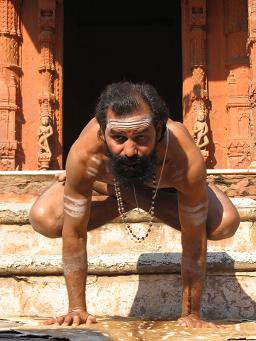“Yoga is music.” Interview with Rakesh Pandey from Varanasi.
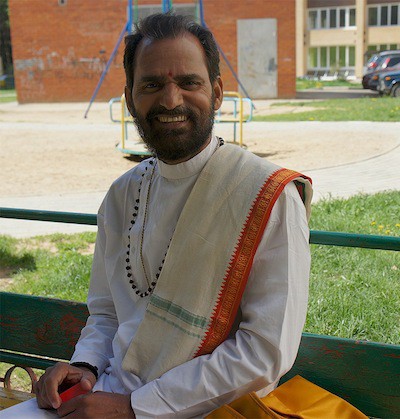
Galina: Could you tell us something about your family, and about how you’ve come to practice yoga?
Rakesh Pandey: It’s difficult to say… It must be my karma from the past life. My father, late S.K.Pandey, was a teacher, a devotee of Lord Shiva. It was my father who introduced me to the Hindu religion. My mother was a housewife. I have three brothers, and four children, from 9 to 15 years old, two of them practice yoga. And I, from my childhood, was very attracted to monks. Whenever I saw a sadhu, a sannyasi, I felt like talking to him, asking questions… always wanted to learn something from them. In this way, I kept searching. My first guru was Swami Nityananda Giri – my guru of kriya yoga (I spent ten years in the monastery with him, from the age of 10). And the second guru – hatha yogi, pandit Raj Bali Mishra. My third guru – in siddha yoga tradition – was Swami Chandra Mohanji Maharaj (Sri Siddha Gufa Yoga Training Center, Sawain village, Agra). I was in contact with him for 2 or 3 years, till his death. Then the fourth guru – in sankhya yoga tradition – Swami Om Prakash Aranyaji Maharaj. It is the fourth lineage of my yoga tradition.
With whom did you study vyayamas (dynamical yogic exercises)? Are they popular in India?
Rakesh Pandey: Yes, quite popular. I studied them with Raj Bali Mishra. He’s now 90… I read about him in a book Ocean to Sky (From the Ocean to the Sky: Jet Boating Up the Ganges) by Sir Edmund Hillary, a New Zealand mountaineer and explorer (Sir Hillary was one of the first two climbers known to have reached the summit of Mount Everest). So in one of the chapters he wrote about a yogi who could hold a jet boat – 200 hp – from moving even an inch! All by the power given by pranayama. So I decided to find that yogi (he lives in Varanasi and Mirzapur), and asked him to teach me. Slowly, slowly he started teaching me – some asanas, then pranayamas… I was his student for four years.
So vyayamas are a part of hatha yoga? Some people say they were taken from the exercises used in preparation for Indian martial arts…
Rakesh Pandey: No, no, it’s a part of traditional hatha yoga. And hatha yoga is a platform for raja yoga, or kriya yoga. First you have to work with your body.
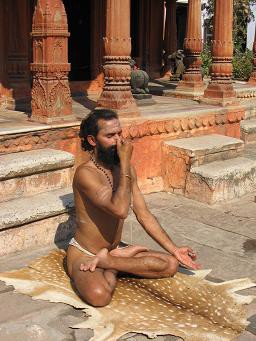
In the West people keep arguing whether being a vegetarian is important for yoga practice. Some say a vegetarian diet is conditioned only by India’s warm climate, and it doesn’t really influence your progress in yoga. What is your opinion on this issue?
Rakesh Pandey: It is absolutely necessary! But in yoga, there should be no pressure. By doing yoga, people do come out of their old habits. I’ve seen it so many times in my practice as a yoga teacher. In the West, people come to me and say: “Now I don’t eat meat, I don’t drink alcohol, I don’t smoke any more…” It happens naturally. Last year when I visited Russia, I stayed with one of my students for about a week. His daughter was 1.5 years old, she was not a vegetarian then. Now she’s one year older, and my student says since last year she refuses to eat meat. He says that was my influence, that I created such an atmosphere… (laughing) I don’t know, maybe I did.
Well, if you can create your own atmosphere, and carry it with you wherever you go… To what extent is it possible to practice yoga as serious sadhana, living in a modern city (even an Indian city)?
Rakesh Pandey: Right, but still, I think it’s impossible in the city. There’s too much tension here. Better go somewhere closer to the nature.
Have you met real ascetics, sadhus, living alone in Himalayas? Wild yogis?
Rakesh Pandey: No, nowadays it’s hard to find such people in India. But it’s not impossible. If you look for such a person, sure you’ll find him, because he’s also looking for you, to teach you, if you really want that to happen. You’re in a sort of a queue – when it’s your turn, the encounter will happen. Just keep searching, keep queuing.
And what about Aghoris? Varanasi is known as one of the centers of Aghori tradition. Now in the West there are many myths and phantasies about this tradition. Do you know any of its representatives?
Rakesh Pandey: There are two main centers in Varanasi itself: Kinaram Ashram and Kustha Seva Ashram. But I was never involved in tantric practices. It’s different from yoga. These five M – it’s actually all about mahabhutas, about sense organs… And there’s so much misconception about them, about tantra, even in India, even among Aghoris: for them, wine is for drinking, women are for having sex with them, etc. And there are no real masters, all are gone.
We’ve heard that you are interested in Kashmir Shaivism. What is it that you like about this tradition?
Rakesh Pandey: I haven’t practiced according to this tradition, I’ve just studied it a little, not going into details…
How important is Shiva Sutra for yoga practitioners?
Rakesh Pandey: Shiva Sutra explains everything about how to be a man, practicing and developing to spirituality. So, if you read Shiva Sutra, it will give you some guidelines – how to do your practice, how to improve what you’re doing now, how to make corrections. It gives a good sight, a good vision – to see if you practice properly or not. If you don’t practice properly, you just change your ways – it gives instructions, and you make improvements by following these instructions.
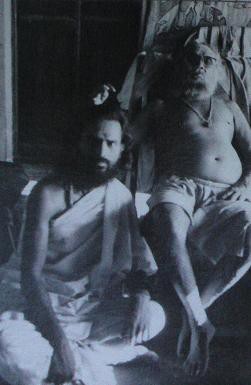
Please tell us a few words about your kriya yoga guru. You live in Varanasi, where Lahiri Mahasai’s family also live. Have you visited his grandson Satyacharan Lahiri?
Rakesh Pandey: Yes, once or twice, but I wasn’t initiated into kriya then. And his son, Shibendu Lahiri, is my gurubhai. This is my lineage: Babaji, Lahiri Mahasai, Swami Kevalananda Giri Ji, Swami Shuddhananda Giri Ji, and my guru Swami Nityananda Giri ji, a very good man.
Is there something specific in the practice of kriya yoga in your lineage?
Rakesh Pandey: Nothing specific, kriya is kriya.
Hatha Yoga Pradipika speaks of mudras and bandhas… Does that mean that the practice of kriya is similar to the practice of hatha yoga, of its higher stages?
Rakesh Pandey: Well, it’s all in one system, just higher stages; it’s all one tradition.
What do you think: does traditional yoga have a chance to survive in the modern world where there’s an increasing amount of commercial fitness yoga, and even Indian teachers start to conform to the Western fashion?
Rakesh Pandey: See how you can practice: you find a guru you can trust, and you keep coming to him, maybe for a week, or for a month, you’re staying with him, he teaches you, makes corrections if necessary, and you return home and proceed with your practice. This is how the traditional yoga can survive – it’s us who is supposed to maintain the tradition, not hoping that someone else will do it, or that it will happen on its own accord.
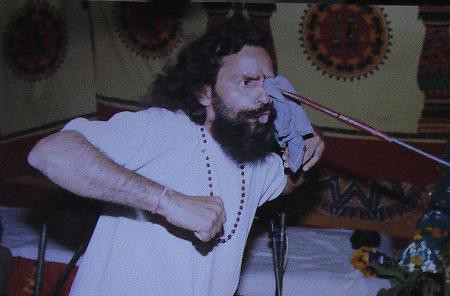
And what about yoga sport championships? There are quite a lot of them in India.
Rakesh Pandey: It’s not a real yoga. In yoga, there can be no competition. When you practice yoga, you drop all competition. If you go to a championship once in a while, it’s okay, but it’s all about asanas, and then you come back, and the real work must go on inside of you. But you see, these championships are a good way to promote yoga, people can get attracted to it, and then go deeper.
What is the difference between a guru and an ordinary yoga teacher?
Rakesh Pandey: There’s a huge difference. With a guru – you are nothing. You give everything, all of yourself to him. You stay with him, you take food in his house… A yoga instructor teaches you asanas, maybe pranayamas for a couple of hours, you pay money – and that’s it, good-bye. With a guru, you also pay money – it is called guru dakshina, – but it’s a different system. You come to your guru with ALL the questions you have, he teaches you life, not just some practices. Sometimes he’s your father, sometimes he’s your mother…
What do you teach during your classes?
Rakesh Pandey: Asanas, bandhas, pranayamas, shatkarmas… Also vyayamas. Then there are also kirtans – to release tension, satsangs…
So, you do enjoy music? Varanasi is known for its rich musical culture… Can you play any instrument?
Rakesh Pandey: I don’t play any musical instruments, I just clap my hands during kirtan, there are many acupuncture points on the palms, you know… If someone brings a musical instrument, it’s always good! I do love music, classical music. My friend plays tabla, and sometimes I come to his house just to listen and see how he plays – his fingers go “Sita-Ram, Sita-Ram, Sita-Ram…” As I say, yoga is music: the rhythm of your body, the melody of your mind, and the harmony of your soul make a perfect symphony of life… I teach same things, whether it is in Varanasi or in Belgorod. My plan is to build an ashram in Varanasi – you come and stay there, not in a hotel, you are on a yogic diet, and you practice yoga – this is how it should be.
Do you initiate your students into kriya yoga?
Rakesh Pandey: Yes, but very rarely, if someone asks me to, and I can see that a person is fit for it.
When you studied in Kaivalyadhama Yoga Institute, did you learn a lot? How has it helped you as a teacher?
Rakesh Pandey: I’ve learnt some new things, not many. But the scientific approach, which is characteristic for Kaivalyadhama, was very valuable for me as a teacher. Having heard many lectures there, I learned how to present the material to students in a more structured way.
And what characteristic is absolutely essential for a yoga teacher?
Rakesh Pandey: It’s simple – he or she must follow the rules. Yama and niyama – if someone’s not following them, such a person cannot call him/herself a yoga teacher. Just physical exercises will be left, gymnastics, but not yoga.
What are objective signs, saying that someone is a realized yogi?
Rakesh Pandey: Well, it’s all in the eyes of a person who’s looking. Say, if you wear red sunglasses, everything looks red for you, if you wear black sunglasses, everything looks black. You must have clear vision, the eyes that are able to see a realized yogi – then only you’ll see him. Same thing is with a guru – the guru is in the eyes of his students.
How do you know that you’re on the right path, that you are progressing in yoga?
Rakesh Pandey: These signs are described in yogic texts. Mostly it is not for someone else to judge. You yourself will see changes in your body and your mind, in your social life also. As for mental changes – your mind will become very sharp; you’ll have a very clear vision. You’ll have absolutely no doubts about whether you are on the right path – you’ll see it clearly.
Moscow, may 2011
Yogacharya Rakesh Pandey lives in Varanasi, and teachs yoga on the rooftop of his house near Hanuman Ghat. Adress: B 4/35, Hanuman Ghat, Varanasi 01. Phone 91 542 227 57 97.
Rakesh Pandey will participate in Yoga-Rainbow Festival in Goa, 10-16 jan 2012 www.rainbow.yogafest.info





